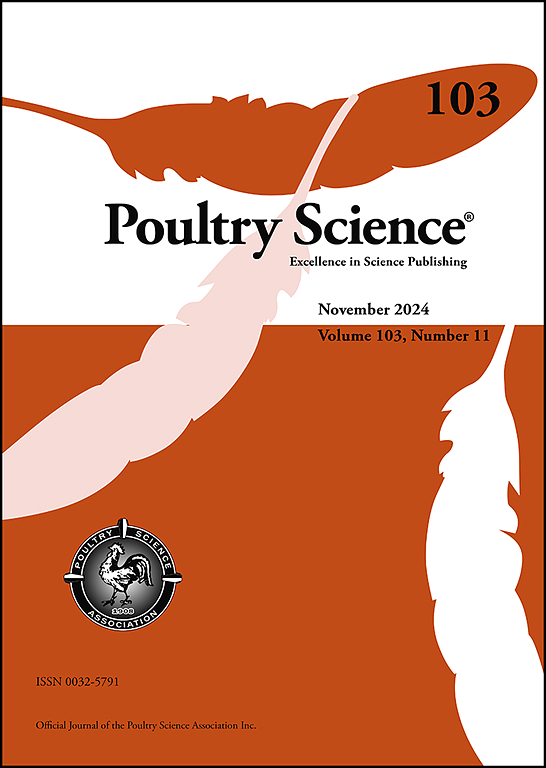Dietary Saccharomyces cerevisiae fermentation product improved egg quality by modulating intestinal health, ovarian function, and cecal microbiota in post-peak laying hens
IF 3.8
1区 农林科学
Q1 AGRICULTURE, DAIRY & ANIMAL SCIENCE
引用次数: 0
Abstract
Saccharomyces cerevisiae fermentation product (SCFP), a postbiotic feed additive, has potential to improve animal growth and productivity. However, its effects on post-peak laying hens have not been thoroughly investigated. Therefore, this study aimed to explore the effects of SCFP on production, egg quality, intestinal health, ovarian function, and cecal microbiota in post-peak laying hens. A total of 600 45-week-old Lohmann pink laying hens were randomly assigned into three treatments, with ten replicates and twenty hens per replicate. The hens were fed either a basal diet (CON) or basal diet supplemented with SCFP at 750 mg/kg (SCFP1) and 1250 mg/kg (SCFP2) for 16 weeks. The results showed no significant effects on the laying performance (P > 0.05). SCFP supplementation increased Haugh unit, yolk color, albumen height, and eggshell ratio compared to the CON diet(P < 0.05). Hens received SCFP diets exhibited a higher intestinal villus height-to-crypt depth ratio (P < 0.05) and up-regulated the expression of jejunal occludin, zonula occluden-1 (ZO-1), and mucin 2 (MUC-2) (P < 0.05). Additionally, SCFP supplementation increased the concentration of jejunal secretory immunoglobulin A (SIgA) (P < 0.05), elevated serum levels of immunoglobulin A (IgA), IgG, interleukin-10 (IL-10), and interferon-γ (IFN-γ) (P < 0.05). Furthermore, dietary SCFP tended to decrease ovarian cell apoptosis and enhanced antioxidant capacity in laying hens (P < 0.05). Compared to CON group, the SCFP1 and SCFP2 groups had lower total bacteria and Escherichia coli, higher Lactobacillus (P < 0.05), and a greater abundance of Streptococcus, Pedosphaerales, Christensenellales, and Prevotellaceae in cecum. Significant correlations were observed between egg quality, intestinal health, ovarian function, and cecal microbiota. In addition, cecal microbial functional prediction indicated that SCFP altered various nutritional metabolism pathways. Dietary SCFP supplementation effectively improved egg quality in post-peak laying hens by modulating intestinal health, ovarian function, and cecal microbiota. Collectively, SCFP could be used as a valuable feed additive for post-peak laying hens, with 1250 mg/kg SCFP showing the better effects.
求助全文
约1分钟内获得全文
求助全文
来源期刊

Poultry Science
农林科学-奶制品与动物科学
CiteScore
7.60
自引率
15.90%
发文量
0
审稿时长
94 days
期刊介绍:
First self-published in 1921, Poultry Science is an internationally renowned monthly journal, known as the authoritative source for a broad range of poultry information and high-caliber research. The journal plays a pivotal role in the dissemination of preeminent poultry-related knowledge across all disciplines. As of January 2020, Poultry Science will become an Open Access journal with no subscription charges, meaning authors who publish here can make their research immediately, permanently, and freely accessible worldwide while retaining copyright to their work. Papers submitted for publication after October 1, 2019 will be published as Open Access papers.
An international journal, Poultry Science publishes original papers, research notes, symposium papers, and reviews of basic science as applied to poultry. This authoritative source of poultry information is consistently ranked by ISI Impact Factor as one of the top 10 agriculture, dairy and animal science journals to deliver high-caliber research. Currently it is the highest-ranked (by Impact Factor and Eigenfactor) journal dedicated to publishing poultry research. Subject areas include breeding, genetics, education, production, management, environment, health, behavior, welfare, immunology, molecular biology, metabolism, nutrition, physiology, reproduction, processing, and products.
 求助内容:
求助内容: 应助结果提醒方式:
应助结果提醒方式:


